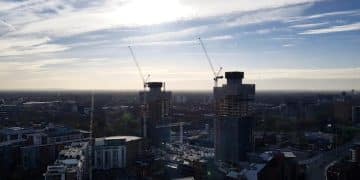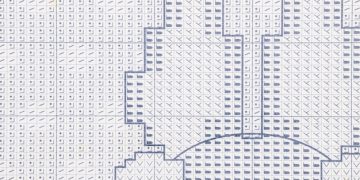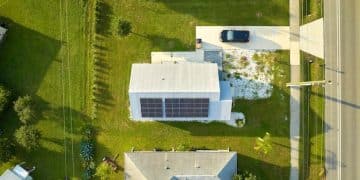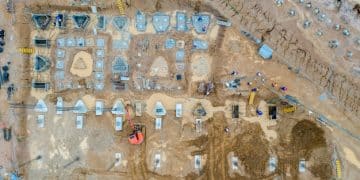Concrete Alternatives: Cost-Benefit for US Construction 2025
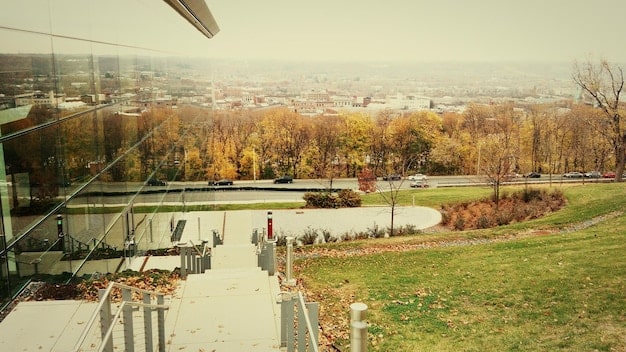
Anúncios
Exploring concrete alternatives: a cost-benefit analysis for US construction in 2025 reveals emerging materials like mass timber and geopolymer concrete offer environmental advantages and potential long-term economic benefits, challenging traditional construction methods for sustainability and efficiency.
As the construction landscape evolves, stakeholders in the United States are increasingly scrutinizing the reliance on traditional materials. A deep dive into concrete alternatives: a cost-benefit analysis for US construction in 2025 is imperative, presenting a nuanced view of emerging solutions that promise both environmental and economic advantages. This exploration aims to offer clarity on innovative materials poised to reshape the industry.
The Push for Sustainable Construction Materials
The global construction industry faces mounting pressure to reduce its environmental footprint. Concrete, while foundational to modern infrastructure, carries a significant carbon burden due to cement production. This has catalyzed a strong movement towards more sustainable alternatives, particularly within the dynamic US construction market. The drive isn’t solely altruistic; it’s increasingly mandated by evolving regulations and demanded by a growing segment of environmentally conscious clients and investors.
This evolving landscape necessitates a re-evaluation of traditional practices. Architects, engineers, and developers are no longer just seeking materials that meet structural requirements; they’re also looking for those that align with broader sustainability goals. This includes considerations for embodied carbon, lifecycle impacts, and resource efficiency. The pursuit of sustainable materials is leading to innovations that challenge long-held conventions, promising a greener and potentially more cost-effective future for construction.
Drivers of Change in Material Selection
Several key factors are compelling the US construction sector to explore concrete alternatives. Regulatory changes, such as updated building codes and green building standards, increasingly favor materials with lower environmental impacts. Financial incentives, including tax credits and grants for sustainable projects, further sweeten the deal for adopting alternative solutions.
- Environmental Regulations: Stricter emissions targets and carbon pricing mechanisms.
- Client Demand: Growing preference for green buildings from both commercial and residential buyers.
- Technological Advancements: New manufacturing processes making alternative materials more viable.
- Material Scarcity & Cost Volatility: Concerns over long-term availability and price fluctuations of traditional concrete components.
Moreover, the reputation and brand image of construction firms are increasingly linked to their sustainability performance. Projects that showcase innovative, eco-friendly materials can attract premium clients and demonstrate leadership in a competitive market. The long-term operational cost savings associated with these materials, such as improved energy efficiency, also play a crucial role in their adoption.
Ultimately, the push for sustainable construction materials is a multi-faceted phenomenon, driven by a convergence of environmental imperatives, economic opportunities, and evolving market expectations. Understanding these drivers is essential for any cost-benefit analysis of concrete alternatives.
Mass Timber: A Renewable Contender
Mass timber, encompassing products like cross-laminated timber (CLT), glued laminated timber (glulam), and nail-laminated timber (NLT), has emerged as a significant contender in the quest for concrete alternatives. Its rapid growth in popularity, particularly in the US, stems from a compelling blend of environmental benefits and structural capabilities that rival or even surpass traditional materials in certain applications. This material offers a refreshing departure from the energy-intensive processes associated with cement and steel production.
The appeal of mass timber extends beyond its renewable nature. It possesses inherent qualities that contribute to more efficient and aesthetically pleasing construction. Its natural beauty and exposed finishes often reduce the need for additional interior treatments, streamlining project timelines and potentially cutting costs. Furthermore, the inherent thermal properties of timber contribute to improved building performance, which can lead to long-term energy savings.
Cost Implications and Benefits of Mass Timber
While the initial material cost of mass timber might sometimes be higher than conventional concrete, a comprehensive cost-benefit analysis reveals compelling advantages over the project lifecycle. Significant savings often arise from the inherent efficiencies of mass timber construction, such as faster erection times on site. Prefabricated mass timber panels arrive ready for assembly, dramatically reducing the labor and time required for framing.
- Accelerated Construction Schedules: Reduced on-site labor and quicker project completion.
- Reduced Foundations: Lighter weight structures may require less extensive foundations.
- Lower Transportation Costs: Often lighter than equivalent concrete elements, potentially reducing shipping expenses.
- Improved Building Performance: Enhanced thermal insulation and potential for reduced operational energy costs.
The embodied carbon of mass timber is significantly lower than that of concrete, as trees absorb CO₂ during their growth. This “carbon sequestration” characteristic makes mass timber an attractive option for projects aiming for specific green building certifications or those with strong environmental mandates. Moreover, the long-term durability and resilience of well-designed mass timber structures contribute to their overall value proposition, offering a robust and sustainable solution for the future of construction.
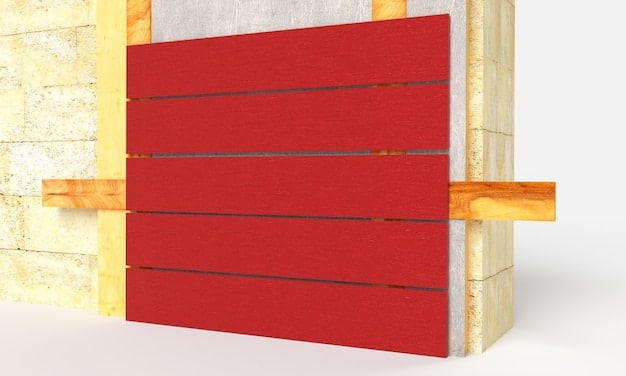
However, successful adoption of mass timber requires expertise in design, fabrication, and construction. Building codes are continually evolving to accommodate this material, and specialized training for construction crews is often necessary. Despite these considerations, the numerous benefits, both environmental and economic, position mass timber as a highly viable and increasingly preferred alternative for various building types in the US construction sector.
Geopolymer Concrete: A Low-Carbon Alternative
Geopolymer concrete represents a fascinating and promising low-carbon alternative to traditional Portland cement concrete. Unlike conventional concrete, which relies on calcined limestone (cement kilns are significant CO₂ emitters), geopolymers utilize industrial byproducts such as fly ash and blast furnace slag, activated by alkaline solutions, to create a binder. This innovative approach drastically reduces the embodied carbon content of the material, making it a frontrunner in sustainable construction. Its potential to transform the concrete industry through a greener manufacturing process is substantial.
The development of geopolymer concrete addresses one of the most pressing environmental challenges in construction: the high carbon footprint of cement production. By diverting industrial waste streams, it also contributes to a circular economy model, turning what would otherwise be discarded into a valuable building material. This dual benefit of carbon reduction and waste utilization makes geopolymer concrete a compelling subject for any serious cost-benefit analysis.
Economic and Performance Characteristics of Geopolymer Concrete
From an economic standpoint, the cost-effectiveness of geopolymer concrete is heavily dependent on the availability and proximity of its source materials—fly ash and slag. In regions with ample industrial activity producing these byproducts, the material costs can be competitive, if not lower, than traditional concrete. However, additional costs may arise from the specialized mixing and curing processes required for geopolymers, which differ from conventional concrete production.
- Reduced Embodied Carbon: Significantly lower CO₂ emissions compared to Portland cement.
- Enhanced Durability: Known for superior resistance to chemical attack and high temperatures.
- Waste Utilization: Converts industrial byproducts into valuable construction materials.
- Variable Cost: Dependent on regional availability of raw materials and processing infrastructure.
In terms of performance, geopolymer concrete exhibits excellent mechanical properties, often achieving comparable or even superior compressive strengths to traditional concrete. Its durability, particularly its resistance to sulfates, acids, and high temperatures, makes it highly suitable for harsh environments or specialized applications where traditional concrete may falter. These enhanced performance characteristics can translate into longer service life for structures, reducing maintenance and replacement costs over time.
Despite these advantages, wider adoption of geopolymer concrete in the US construction market faces challenges, including the need for standardized specifications, increased public awareness, and the development of a more robust supply chain. Nevertheless, its potent combination of environmental benefits and strong performance positions it as a vital component in the future of sustainable infrastructure development.
Recycled and Waste-Derived Aggregates
The practice of incorporating recycled and waste-derived aggregates into concrete mixes, though not a complete alternative to concrete itself, significantly reduces the environmental impact of new concrete production. This approach focuses on optimizing resource utilization and minimizing landfill waste, addressing key sustainability concerns within the US construction industry. It represents a pragmatic and readily adoptable strategy for enhancing the circularity of construction materials, offering an immediate avenue for greener practices without requiring a wholesale shift away from concrete. This method helps to conserve virgin aggregates, which are non-renewable resources, and reduces the energy associated with extracting and transporting new materials.
The principle is simple yet powerful: instead of discarding construction and demolition waste, or industrial byproducts, they are processed and reused as substitutes for natural sand and gravel in concrete. This not only mitigates the environmental burden of waste disposal but also lessens the demand on finite natural resources, contributing to a more sustainable supply chain. The benefits extend beyond environmental protection to include economic advantages and improved project efficiency.
Feasibility and Economic Advantages
The economic feasibility of using recycled and waste-derived aggregates is often project-specific, depending on the availability of suitable waste streams, processing facilities, and transportation costs. However, in many urban and industrial centers, these aggregates can offer significant cost savings, especially when proximity to demolition sites or industrial plants reduces hauling distances. This localized availability can make them a highly attractive option for contractors looking to optimize their material procurement.
- Reduced Landfill Costs: Diverting waste from landfills saves on disposal fees.
- Lower Material Costs: Recycled aggregates can be cheaper than virgin materials.
- Reduced Transportation: Sourcing locally available waste reduces fuel and logistics costs.
- Circular Economy Benefits: Enhances resource efficiency and reduces environmental footprint.
From a performance perspective, extensive research has shown that concrete incorporating recycled aggregates can meet necessary strength and durability requirements for many applications. Quality control, proper processing, and careful mix design are crucial to ensure performance. The US construction sector is increasingly embracing these materials, with federal and state initiatives promoting their use in various infrastructure projects. As technology for sorting and processing waste improves, the range of suitable recycled aggregates, from crushed concrete to glass and rubber, continues to expand, further solidifying their role in a sustainable 2025 construction landscape.
Incorporating these materials also enhances the green credentials of construction projects, aiding in achieving sustainability certifications and appealing to clients with eco-conscious objectives. The long-term economic and environmental benefits of these aggregates make them an indispensable part of the strategy for reducing the environmental impact of concrete production in the US.

Modular and Prefabricated Construction
Modular and prefabricated construction, while not an alternative material itself, fundamentally alters how building materials, including concrete alternatives, are utilized. This method involves manufacturing building components or entire volumetric units off-site in a controlled factory environment before transporting them to the construction site for assembly. The inherent efficiencies of this approach extend beyond cost and time savings to significantly impact material waste and quality control. By moving construction activities indoors, adverse weather conditions are no longer a factor, leading to more predictable timelines and reducing the risk of material damage.
This method offers a systematic way to implement new materials with greater precision and less waste. Whether working with mass timber panels, geopolymer precasts, or other innovative solutions, modular construction ensures optimal material usage, cutting down on scraps and misfabrication. This streamlined process also means less on-site disruption, improved safety conditions, and potentially higher quality finishes due to manufacturing line precision. The shift towards off-site construction is gaining significant traction in the US, driven by labor shortages, the demand for faster project delivery, and a growing emphasis on sustainable practices.
Optimizing Material Use and Efficiency
The cost-benefit analysis of modular construction reveals substantial savings derived from reduced waste, improved labor efficiency, and accelerated project timelines. By producing components in a factory setting, material consumption can be precisely controlled, leading to significant reductions in waste compared to traditional on-site construction. This efficiency extends to labor; a controlled environment allows for specialized skills to be utilized more effectively, enhancing productivity.
- Waste Reduction: Minimized material cut-offs and scraps due to optimized fabrication.
- Labor Efficiency: Specialized factory workforce and streamlined assembly processes.
- Faster Project Completion: Simultaneous on-site foundation work and off-site module fabrication.
- Enhanced Quality Control: Consistent manufacturing standards in a controlled environment.
Moreover, the integration of new concrete alternatives within a modular framework becomes more attractive. For example, large mass timber panels can be precisely cut and assembled into modules in a factory, then quickly erected on site, reducing the complexities often associated with novel materials. This synergy between innovative materials and advanced construction methods creates a powerful combination for sustainable and efficient building. As the US construction industry looks towards 2025, modular and prefabricated approaches will play an increasingly vital role in making concrete alternatives not just viable, but preferable, for a wide range of projects, accelerating their adoption and amplifying their benefits.
Future Outlook and Policy Landscape
As 2025 approaches, the future of construction in the US is undeniably moving towards greater sustainability and innovation. The landscape for concrete alternatives is evolving rapidly, driven by technological advancements, shifts in economic priorities, and an increasingly supportive policy environment. This dynamic interplay will fundamentally reshape material selection, project design, and construction methodologies across the nation. The momentum behind green building initiatives is set to continue, pushing the boundaries of what is considered standard practice and bringing alternative materials further into the mainstream.
A key aspect of this future outlook involves integrating new materials into existing supply chains and regulatory frameworks. This requires proactive engagement from industry stakeholders, research institutions, and government bodies to ensure smooth transitions and widespread adoption. The long-term vision is one where sustainable construction is not merely an option but the default, supported by a robust ecosystem of material suppliers, skilled labor, and supportive policies.
Government Initiatives and Industry Adaptation
Government policies and regulations are pivotal in accelerating the adoption of concrete alternatives. At the federal level, initiatives like the Inflation Reduction Act provide significant tax credits and incentives for sustainable construction practices and materials. State and local governments are also enacting more stringent building codes, mandating lower embodied carbon in new constructions, and promoting the use of recycled content. These legislative measures create a strong economic incentive for developers and contractors to explore and implement alternative materials.
- Federal Incentives: Tax credits and grants for green building and sustainable materials.
- Updated Building Codes: Mandates for lower embodied carbon and improved energy performance.
- Research & Development Funding: Investments in new material science and manufacturing processes.
- Public Procurement Policies: Government agencies prioritizing sustainable materials in public works.
The industry itself is responding with significant investments in research and development, supply chain optimization, and workforce training. Academic institutions are focusing on material science, engineering solutions, and lifecycle assessments of alternative materials. Manufacturers are scaling up production capabilities for mass timber, geopolymer concrete, and other innovative products. As these diverse efforts align, the availability, affordability, and acceptance of concrete alternatives are set to dramatically increase, positioning the US construction sector for a more sustainable and resilient future beyond 2025.
This collaborative approach, combining policy support with industry innovation, will be crucial in overcoming remaining hurdles and ensuring that these promising alternatives not only gain traction but also become integral to the standard practice of building in the United States. The shift signals a new era for construction, prioritizing environmental impact alongside economic viability and structural integrity.
| Key Alternative | Brief Description & Benefit |
|---|---|
| 🌳 Mass Timber | Renewable, low carbon, offers faster construction times and aesthetic appeal. |
| 🔬 Geopolymer Concrete | Utilizes industrial byproducts minimizing CO₂ emissions, with high durability. |
| ♻️ Recycled Aggregates | Reduces waste and demand for virgin materials, often leading to cost savings. |
| 🏗️ Modular Construction | Enhances material efficiency and speeds up project delivery by off-site fabrication. |
Frequently Asked Questions About Concrete Alternatives
Mass timber refers to engineered wood products like CLT and glulam, used for structural applications. It’s sustainable because wood is a renewable resource, sequesters carbon dioxide, and its production requires less energy compared to steel or concrete. This contributes significantly to reducing the embodied carbon of buildings, aligning with modern green building standards.
Geopolymer concrete significantly reduces carbon emissions because it replaces Portland cement, the production of which is highly carbon-intensive. Instead, it uses industrial byproducts like fly ash and blast furnace slag as binders. These materials require less energy to process and divert waste from landfills, resulting in a much lower carbon footprint for the final product.
Yes, when properly processed and utilized, recycled aggregates are safe and effective. They are derived from construction and demolition waste, such as crushed concrete or asphalt, and can meet the necessary performance specifications for various applications. Their use conserves natural resources, reduces landfill waste, and can often be a cost-effective solution, especially in urban areas.
The economic benefits include reduced long-term operational costs due to better energy efficiency, potential savings from faster construction times (e.g., with mass timber), and lower disposal costs by using recycled materials. Additionally, accessing green building incentives, improving brand image, and meeting client demand for sustainable projects can lead to a competitive advantage and higher market value.
By 2025, policy and regulation are expected to heavily influence adoption through stricter building codes, mandates for lower embodied carbon, and increased incentives for green construction. Federal initiatives and state-level programs will push for sustainable material use in public and private projects, making it more economically viable and often a requirement for new developments across the US.
Conclusion
The detailed cost-benefit analysis of concrete alternatives: a cost-benefit analysis for US construction in 2025 reveals a compelling shift in the industry’s material paradigm. As environmental consciousness grows and regulatory landscapes evolve, the transition toward sustainable construction practices is not merely an idealistic pursuit but an economic imperative. From the renewable strength of mass timber to the low-carbon promise of geopolymer concrete and the resource efficiency of recycled aggregates, innovative solutions are poised to redefine building standards in the United States. These alternatives promise reduced environmental impacts, significant long-term operational savings, and expedited construction timelines. The synergy between ongoing research, proactive policymaking, and industry adaptation will undeniably accelerate their widespread adoption, shaping a more resilient and sustainable future for the entire US construction sector. Embracing these materials will be key to both ecological stewardship and competitive advantage.
